Muzzle rise
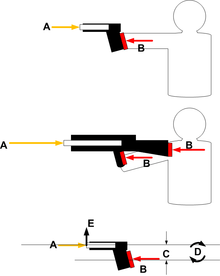
Muzzle rise, muzzle flip or muzzle climb refer to the tendency of a firearms or airguns' front end (muzzle) of the barrel to rise up after firing.[1]
Muzzle climb more specifically refers to the elevation of muzzle of the firearm, caused by combined recoil from multiple shots being fired in quick succession. It has an adverse effect on accuracy of automatic and rapid-fire semi-automatic firearms, causing a target to be overshot.
The primary reason for muzzle rise is that for nearly all guns, the bore axis (longitudinal centerline of the barrel) is slightly above the gun's center of mass, while the contact points between the shooter and the gun (e.g. grips and stock) are often all below the center of mass. When the gun is fired, the bullet motion and the escaping propellant gases exert a reactional recoil directly backwards along the bore axis, while the countering forward push from the shooter's hands and body are well below it. This creates a couple, a rotational torque around the center of mass, which causes the gun the pitch upwards and the muzzle end to rise.
Muzzle rise can be reduced by:
- adding more ergonomic contact points (such as a buttstock) for more efficient exertion of gripping forces
- reducing the vertical distance between the barrel and the contact points
- lowering the recoil by using less powerful rounds
- lowering the recoil by lowering the rate of fire of fully automatic weapons, or supplanting the full-auto mode with burst mode
- lowering the backward recoil with devices such as muzzle brakes, which vector away part of the overall recoil
- lowering the recoil with a suppressor, which slows down the escaping propellant gas and reduces the backward recoil
- compensating for the couple using a recoil compensator, ported barrel, or asymmetric muzzle fixture
- increasing the moment of inertia by attaching additional weight to the muzzle end, but this is unusual
- increasing the rate of fire of burst-fired firearms to allow the muzzle less time to rise
Designs
A number of firearms have been designed specifically to address the issue of muzzle rise.
The Jatimatic submachine gun is an example of a firearm where the bore axis is inclined against the bolt and the rest of the firearm in order to redirect the recoil force slightly upwards. The KRISS Vector submachine gun uses a more elaborate mechanical articulated mechanism which allows the block and bolt to recoil not just rearward like most other firearms, but back and then 'vectored' down off-axis along a rail system behind the weapon's magazine well to reduce muzzle rise and felt recoil.
The Hudson H9, introduced in 2017, is based on the M1911 but has the recoil spring down in front of the trigger guard, resulting in a barrel very close to the top of the shooter's grip, with the creator claiming that, "the recoil impulse from that recoil spring is directed into the meat of your hand."[2]
Gallery
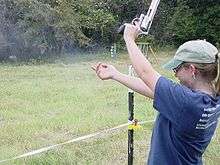 The recoil from the .500 S&W Magnum cartridge inducing significant muzzle rise during firing a Smith & Wesson Model 500 revolver.
The recoil from the .500 S&W Magnum cartridge inducing significant muzzle rise during firing a Smith & Wesson Model 500 revolver.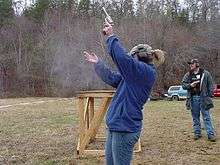 The recoil from the .500 Linebaugh cartridge inducing significant muzzle rise during firing a Ruger Bisley revolver.
The recoil from the .500 Linebaugh cartridge inducing significant muzzle rise during firing a Ruger Bisley revolver.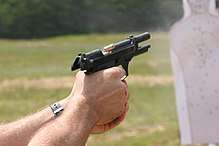 Beretta M9 semi-automatic pistol exhibiting muzzle rise just after firing a 9×19mm Parabellum cartridge.
Beretta M9 semi-automatic pistol exhibiting muzzle rise just after firing a 9×19mm Parabellum cartridge.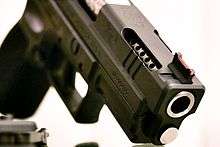 Springfield-Armory custom XD-40 V-10, showing a ported barrel and slide intended to reduce muzzle rise.
Springfield-Armory custom XD-40 V-10, showing a ported barrel and slide intended to reduce muzzle rise.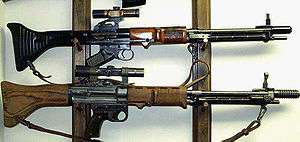 The FG 42 battle rifle/automatic rifle was one of the first inline fire arms incorporating a "straight-line" recoil configuration to reduce muzzle rise.
The FG 42 battle rifle/automatic rifle was one of the first inline fire arms incorporating a "straight-line" recoil configuration to reduce muzzle rise.- An AKM assault rifle asymmetric slant cut muzzle fixture designed to counteract muzzle rise (and muzzle climb) during (automatic) firing.
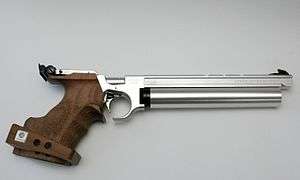 The barrel of the Steyr LP 10 PCP air pistol has three holes drilled on top along its length to counteract muzzle rise.
The barrel of the Steyr LP 10 PCP air pistol has three holes drilled on top along its length to counteract muzzle rise.
References
- ↑ Recoil management: how you hold makes all the difference, Guns Magazine, Oct 2006 by Dave Anderson
- ↑ Slowik, Max (2017-01-11). "The Hudson Mfg. H9: Rethinking Handgun Design". GunsAmerica Digest. Retrieved 2017-01-30.